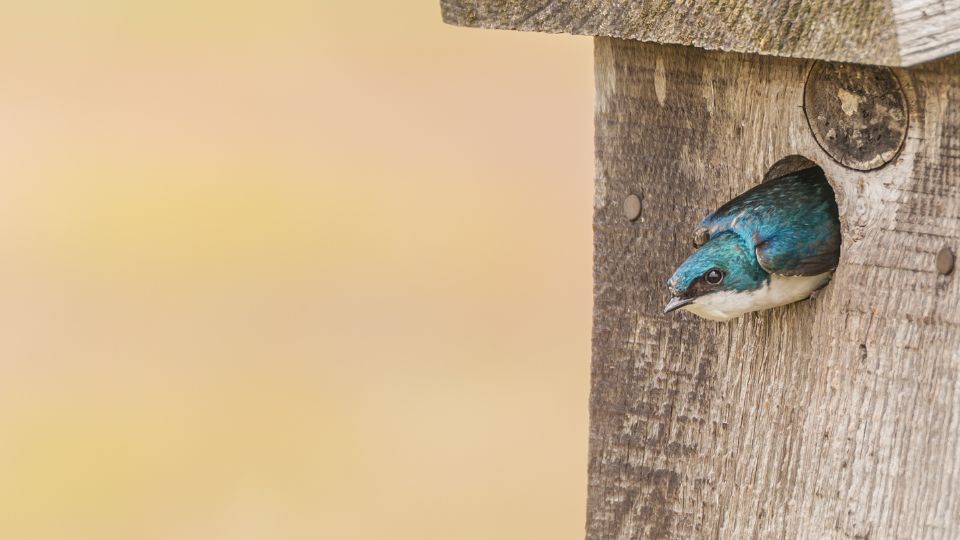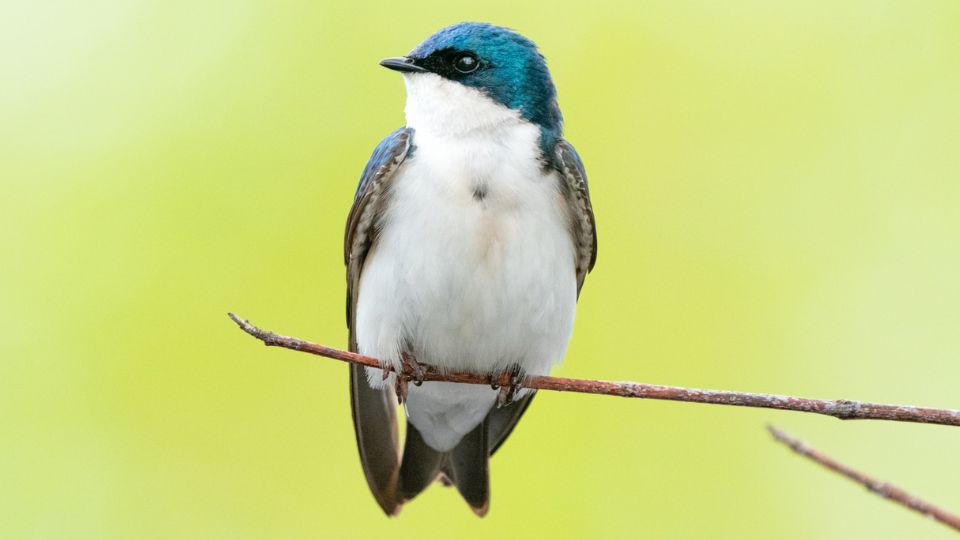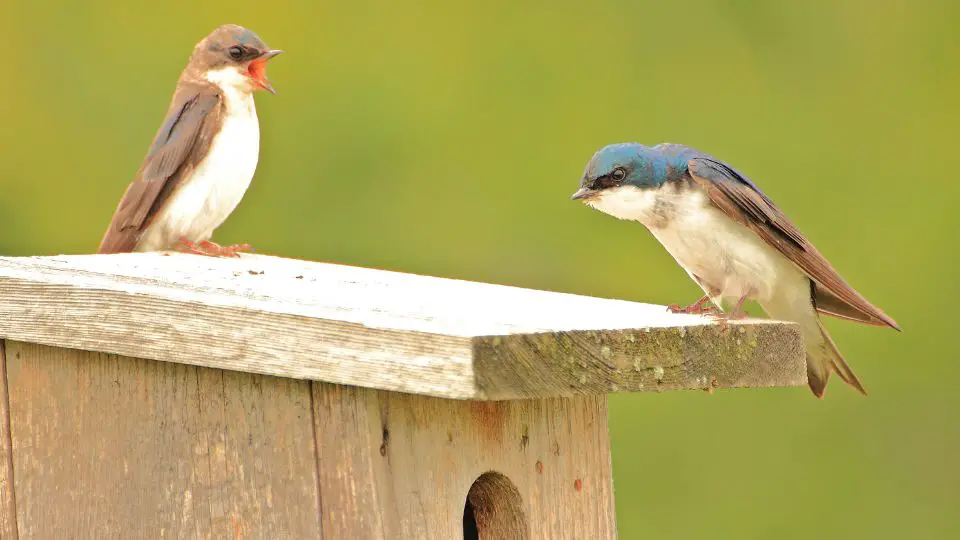Swallows songbirds are cavity-nesting birds that use bird houses, dead tree holes, and old woodpecker nesting sites to nest. You can assemble a swallow bird house by creating a mud nest and placing it in a sheltered box.
Barn swallows cover a lot of ground. During the nesting season, they are found in every corner of North America (even Canada) and migrate south to Mexico. These wild birds have a beautiful coat of glossy black and steely blue feathers with a white underbelly and are a little shy about visiting backyard spaces.
If you want to attract these lovely birds to your backyard space, it requires a little bit of work. They’re not exactly shy or afraid of humans- they’re very particular about where they nest.
Check out these tips below on building the ultimate swallow nest and other information on attracting these beloved songbirds to your backyard space.
How to Build a Swallow Bird House
The great thing about building your Swallow nesting box is that it doesn’t require any carpenter skills. Since swallows prefer mud nests, it requires a bit of plaster of pairs, a template (such as a ball), hooks, and some screws for mounting.
Materials needed:
- Gloves
- Backing Board
- Hooks
- Screws
- Small ball or balloon
- Plaster of Paris
Building Instructions:
Step 1 – Mix your plaster of paris via the instructions on the container. Be sure to wear gloves to prevent your hands from burning when working when shaping your nest.
Step 2 – Lay a generous layer of plaster on a quart of the ball or balloon to make a cup-like shape, and place two hooks on either side of the plaster nest before it dries for easy mounting.
Step 3 – Once the plaster dries, mount the cup-shaped nest to a backing board, and place it under an overhang for protection from the elements at least 8 feet off the ground.

Swallow Nesting Box Construction Tips
Make it look natural – When your plaster dries, it looks fresh and bright white. To make your nesting box look more natural, rub a little mud on the outside of the plaster to give it a more organic look.
Reduce hazards – Your nesting cup might have sharp edges on the front of the cup when it dries. To protect nestlings and fledglings, you need to smooth down any sharp edges with sandpaper.
Make the nest softer – Add dried grass clipping or straw inside the nesting box before hanging it. Placing nesting material inside your swallow bird house will make it more attractive to the songbirds.
Install predator guards – Install a predator guard. When mounting your swallow bird house to a pole, you must ensure it’s safe from predators. A handcrafted predator guard attaches to the pole’s base and is made from simple household items like tin cans to block predators from climbing up the rod. If you don’t want to make a predator guard, you can buy one on Amazon or your local wildlife hobby shop.

Where Do Swallows Nest?
Tree swallows and barn swallows are both cavity-nesting birds. They prefer to construct nests in the remains of old woodpecker nests, but they also make nests in the eaves of a barn, on bridges, cliffs, or canyons. Due to their unique use of nesting material, they prefer to select locations near water sources to expedite the long building process.
Overall, most swallows prefer nesting sites in open areas and fields to make their nest in lush forests. Most Swallows prefer to build nests at least 300 feet from the edge of a forest. If you are near a thick forest, it may be challenging to attract tree swallows and barn swallows to your backyard.
In our video below, we rounded up 7 little known facts about swallows!
What Nesting Material do Swallows Use?
Swallows make their nests using mud pellets and grass, which is quite unusual compared to other songbirds like nuthatches, bluebirds, house sparrows, chickadees, and finches. Their mud-constructed nests are called adherent cups and are quite time-consuming to construct.
Swallows swoop down to a nearby river, lake, or mud puddle to form mud pellets with their beaks to make these individual nests. Both parents work together to construct their nest of almost 1,000 mud pellets!
This process is pretty time-consuming and takes up to 2 weeks to complete. The finished product looks like tiny little bird bricks and serves to keep predators away.

Why Won’t Swallows Use My Nesting Box?
Swallows will not use a nesting box in a bad location, and that is not close to a food and water source. If the nesting box is not hung in time for their nesting season, it will probably go unused.
Swallows are very particular about the location of their nests. If your nesting box is near backyard traffic, they will be less likely to use your nesting box. Always place nesting boxes in a secure location free of predators (and humans) and at least 8 feet off the ground.
It’s not close to a food and water source. Swallows make their nests out of mud, so your nesting box should be near rivers, bird baths, mud puddles, or other water and mud sources. Also, stock your birdfeeder with some of their favorite food!
If you found no swallows used your nesting box this season, it may just mean they didn’t see it! Before you take it down or move it to a better location, hold off for a year. Often, young broods take notice of the nesting box at the end of the season and return to use it when they migrate north for the breeding season.
Always clean out nesting boxes. When a brood leaves the nest for the season, they also leave behind bacteria and bugs. When you notice that a family of Swallows has left the nest, take it down and clean it with a 2 percent solution of bleach and water. Bleach kills bugs and bacteria, making it safe for a new family to nest.

Why swallows are always welcomed visitors
Swallows are a welcome addition to any backyard space because they are natural source of pest control. If bugs eat up your garden, attracting swallows to your backyard is a great way to keep those pests in check!
Since swallows often roost in the eaves of a barn or a roof, building an outdoor bird house is a great way to attract these lovely songbirds to your backyard. However, swallows love wide open spaces, so unless you live within a dense forest, it may be challenging to attract them to your bird house.

